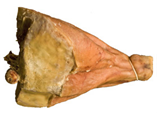|
|
THE SALUMI MENU
|
|||
|
Bresaola
(bres-ay-ola)
|
Whole muscle beef that has been salted -- and sometimes seasoned with red wine
and spices -- and then air-cured.
Originally produced in northern Italy, there are versions of dried beef made
across the globe ranging from carne de sol in Brazil to bindenfleisch in
Switzerland. The lean, dark red meat is served sliced paper thin -- often with a drizzle of olive oil, Parmesan cheese, ground black pepper and
lemon juice.
|
 |
|
|
|
Cacciatore
(kah-cha-tor-ay)
|
Cacciatore means “hunter-style.” These hand-sized dry pork sausages were made to be carried in a pocket and
munched while hunting or hiking. This salami is made throughout Italy and is
often seasoned with black pepper, juniper, garlic and wine, and may come in hot
or sweet varieties. It is typically served on antipasto plates or as part of a
simple rustic picnic with cheese, bread and wine.
| 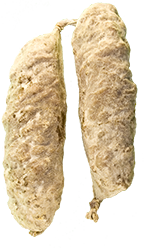 |
|
|
|
Ciauscolo
(-----)
|
|
|
|
|
|
Coppa / Capocollo
(koe-puh / kap-pa/kole-a)
|
This Neapolitan specialty is a roll of pork neck or shouldr meat with thin
ribbons of fat throughout. It is produced in a natural casing that is air-dried
and traditionally made in two varieties, hot and sweet. The dark-hued meat is
sliced very thinly on sandwiches and on antipasto platters, often wrapped
around sliced of ripe melon. As seen on “The Sopranos,” is is also known as “gah-ba-gool.” Coppa is the pork equivalent of the beefy bresaola.
|  |
|
|
|
Cotecchino
(-------)
|
|
|
|
|
|
Cotto
(-------------)
|
|
|
|
|
|
Crespone
(-------------)
|
|
|
|
|
|
Culatello
(coo-lah-tell-o)
|
Made from a single pork muscle -- the leg tissue inside the larger cut that’s traditionally used to make prosciutto. The word culatello means “little backside.” It is rubbed with red wine and salt, stuffed in a pig bladder and hung to dry
age for three to twelve months. The string-tied, pear-shaped salumi originates
from the region around Parma. The dark red meat is served very thinly sliced as
with prosciutto and served on antipasto plates and with fresh figs or melon.
| 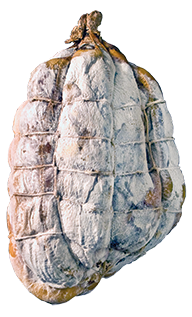 |
|
|
|
Finocchiona
(--------------)
versions: Fiochetto
|
Tuscany’s famed fennel sausage owes its origins to a thief. He supposedly stole a salame
and hid it in a field of wild fennel. Upon retrieval he realized it had
absorbed the aromas of its hiding place, and so began the practice of adding
fennel seeds to salami. Now made in the U.S., look for a natural casing dusted
with powdery white mold and expect the beautiful melding of sweet pork and
licorice-y fennel.
|
 |
|
|
|
Genoa salami
(jen-oh-uh sa-lam-ee)
|
A highly popular American cold cut used in sandwiches, one of the many varieties
of salami. This salumi is based on a standard orginating in Genoa (Genova, in
Italian). It is a softer textured salami composed of finely ground pork and
beef plus salt, black peppercorns, garlic, fennel seeds, and wine stuffed in a
casing and air-dried. The tangy taste results from fermentation. Sliced Genoa
salami is primarily used in sandwiches. The largest-sized Genoas yield slices
suited for this application — a single slice is all that’s needed to cover a slice of bread — but they can vary considerably in diameter from producer to producer.
|
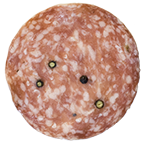 |
|
|
|
Guanciale
(gwan-she-a-lay)
|
Salted, air-dried pork cheek and jowl meat, similar to un-smoked bacon but with
a chewier texture and more pronounced pork flavor. It originates in central
Italy -- including Umbria. Guanciale is often seasoned with black pepper,
herbs, bay leaf, and juniper berries. It is used mostly in cooked dishes such
as spahetti alla carbonara, or diced and fried and added to cooked eggs.
|  |
|
|
|
Lardo
(lard-oh)
|
One type of traditional salumi has garnered a great deal of comment and press
simple because of its name: lardo. Lardo is a slab of thick fatback — the same cut used in baked beans, Southern cookery and the lard that makes the
flakiest pie crusts. It’s salt- and herb-cured for several weeks to several months (the largest slabs --
from pigs weighing 300 pounds or more -- can take up to a year to cure). The
resulting product is often sliced very thin and served atop warm bruschetta for
a melt-in-the-mouth delicacy. Several Italian towns are known for their salumi,
the most famous being Lardo di Colonnata, in the north near the Apuan Alps. A
whipped spreadable version is sometimes served instead of butter with bread.
Also popular in Eastern Europe, lardo is known as
salo (Russia, Ukraine) and slanina (Romania, Croatia, Czech Republic).
|
|
|
|
|
Lomo
(-----)
|
|
|
|
|
|
Lonza
(-----)
also known as
capelomme
|
From Aburzzo, lonza is made with pork loin and air- or smoke-dried. It is dark
red in color, with streaks of pork fat. Typically about 12 inchles long (30 cm)
and a little less than 1/2 inch (10 cm) in diameter.
|  |
|
|
|
Mortadella
(mort-a-dell-ah)
|
Mortadella is a large cooked salami composed of finely minced or emulsified pork with
lardons (cubes) of fat, wine, white pepper, pistachios, and green olives in a
natural casing. Mortadella originates in the city of Bologna and gave rise to
its more familiar American descendant, bologna (pronounced ba-loan-ee), and its cousin, olive loaf. It should be kept refrigerated and sliced thinly
for use in sandwiches and on antipasto plates
| 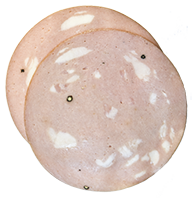 |
|
|
|
Nduja
(en-doo-yah)
|
Originating in Calabria in Italy, nduja is a soft salume that is cured in a casing but is spreadable. Typically seasoned with hot peppers and noted for its reddish color and spicy flavor.
|
|
|
|
|
Pancetta
(pan-chet-tah)
|
Pancetta is sometimes called “Italian bacon,” but it is never smoked like the classic American version. Made from pork belly,
it is simply salted and seasoned, often with fennel seed, black pepper, and
cloves. Pancetta can be made either flat or in a roll — the latter produces slices that look like the round bacon on fast food breakfast
sandwiches. A traditional specialty of Calabria, it is mostly used in cooked
dishes to enhance sauces or braising liquids for meats and as a replacement for
guanciale.
|
 |
|
|
|
Pepperoni
(pep-per-o-nee)
|
Pepperoni may be the most popular form of salumi in the United States due to its
widespread use on pizzas. This thumb-thick, dry-cured salami is most often
composed of finely ground beef and pork and liberally seasoned with salt and
red and black pepper. Pepperoni is Italian-American in origin and derived from
the Southern Italian salsiccia piccante and sopresatta dry sausages. It can
also be used in calzones, casseroles, and diced in scrambled eggs.
|
 |
|
|
|
Prosciutto
(pro-shoot-o)
|
Prosciutto is simply the Italian word for ham. In the States, we specifically
associate prosciutto with the whole hind legs of a hog, salt- and air-cured
until firm and dry; in Italy, prosciutto crudo (raw) and cotto (cooked) are
distinct categories. Parma is considered the finest prosciutto-producing region
in Italy, and the legs from this area have esteemed D.O.P. protection,
indicating their origin. Whey from the equally famous Parmigiano-Reggiano is
fed to the pig that will one day become Prosciutto di Parma. The legs are
salt-cured for several weeks, and then hung for nine to eighteen months for
aging. The result is a leathery exterior of inedible skin that protects
firm-yet-tender rosy-red ham, best sliced paper thin.
|
|
|
|
|
Salametto
(------------)
|
|
|
|
|
|
Salami
(----)
|
One of the most generic of Italian cured sausages, traditionally linked to central and southern regions, but available in a wide variety of local styles. Historically, salami was made from pork, but contemporary variations include those made with beef. Characterized by finely ground meat and simple seasonings: salt, pepper, and garlic are the most common.
|
 |
|
|
| Salsiccia | A spicy sausage traditionally seasoned with fennel. | |||
|
Speck
(speck)
|
Similar to prosciutto, this is a cured hog leg that originates from the region of Alto Adige. Usually smoked, and often seasoned with salt, pepper, and juniper berries. The same term is used for a German cured meat, but the German form is lardo, consisting only of pork fat.
|
|
|
|
|
Sopresatta
(so-pre-saht-tah)
|
A rustic dry-cured pork salame that is traditionally pressed down with weights
to yield a flatter, oblong shape (some sopresattas are not pressed and are
rounder in shape). Often spiced with garlic, paprika, red pepper, and black
peppercorns. Originated in southern Italy, especially Calabria. It is used very
thinly slice on pizza and on antipasto plates.
|
 |
|
|
|
|
|
|
|
|


